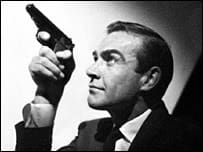Here’s a recently disclosed missive at lettersofnote.com. It’s from Major Boothroyd to author Ian Fleming about British Secret Service agent James Bond’s choice of handguns. Note: James Bond was—and remains—a fictional character.
KEMSLEY HOUSE, LONDON, W.C.1.
31st May, 1956
Dear Mr Boothroyd,
I really am most grateful for your splendid letter of May 23rd.
You have entirely convinced me and I propose, perhaps not in the next volume of James Bond’s memoirs but, in the subsequent one, to change his weapons in accordance with your instructions.
Since I am not in the habit of stealing another man’s expertise, I shall ask you in due course to accept remuneration for your most valuable technical aid.
Incidentally, can you suggest where I can see a .38 Airweight in London. Who would have one?
As a matter of interest, how do you come to know so much about these things? I was delighted with the photographs and greatly impressed by them. If ever there is talk of making films of some of James Bond’s stories in due course, I shall suggest to the company concerned that they might like to consult you on some technical aspects. But they may not take my advice, so please do not set too much store by this suggestion.
From the style of your writing it occurs to me that you may have written books or articles on these subjects. Is that so?
Bond has always admitted to me that the .25 Beretta was not a stopping gun, and he places much more reliance on his accuracy with it than in any particular qualities of the gun itself. As you know, one gets used to a gun and it may take some time for him to settle down with the Smith and Wesson. But I think M. should advise him to make a change; as also in the case of the .357 Magnum.
He also agrees to give a fair trial to the Bern Martin holster, but he is inclined to favour something a little more casual and less bulky. The well-worn chamois leather pouch under his left arm has become almost a part of his clothes and he will be loath to make a change though, here again, M. may intervene.
At the present moment Bond is particularly anxious for expertise on the weapons likely to be carried by Russian agents and I wonder if you have any information on this.
As Bond’s biographer I am most anxious to see that he lives as long as possible and I shall be most grateful for any further technical advices you might like me to pass on to him.
Again, with very sincere thanks for your extremely helpful and workmanlike letter.
Yours sincerely
(Signed)
IAN FLEMING
G. Boothroyd, Esq.,
17, Regent Park Square,
Glasgow, S





Bond just wouldn’t have been the same with a S&W model 37.
What a fantastic way of humoring this Major Boothroyd. Fleming was a cheeky fellow, wasn’t he?
I’ll have to agree with Pie though, I don’t think an Airweight would have been the right choice for Mr. Bond. There isn’t a supressor in the world that would make a .357 revolver quiet enough for 007’s work. Aside from the matter of terminal performance–007 being quite the marksman–I’m sure he’d appreciate not having to police his brass after an assassination, Bond strikes me as a man who could figure out any number of alternatives to using a pistol if he were to find policing brass too tedious.
It’s flattering I think that Fleming had a character named “Boothroyd” (better known simply as Q) make essentially the same argument when they compelled Bond to adopt the iconic Walther.
Fleming wrote Major Boothroyd into his later novels (as “M”, instead of “Q” IIRC) and in the novel “Dr. No” he issues Bond a S&W Airweight. I don’t recall that Bond liked it very much, since he found it useless against the flamethrower that barbecued his local liason Quarrel.
The lowly .25 caliber has all the stopping power of a rimfire cartridge at three times the cost of a centerfire.
Fleming is also credited as the brains behind Operation Mincemeat. There’s a book and a decent 1956 movie called “The Man Who Never Was” that details the whole thing.
James Bond was supposed to be a cold war assassin. Cold war assassins used .22LR, .25ACP, and 5mm pistols more than anything else.
-D
argue all you want about hoe the .22 is a better choice than a .25 ACP, but when the pocket guns were designed, the .22 rimfire was not a good candidate for a self loading pistol(which is the reason for the .25 (6.35) round being developed. No one wants to take a bullet in a robbery. These vest pocket handguns saved the virtue of the dates of better dressed(richer) man or the time. The .25 round is also more reliable(still) in these small semi autos. While LE sometimes gets involved with drugged up and crazy types, most strong arm robberies are cut and dried. A .25(or .22) round placed anywhere into someone’s body will usually have him wanting to be somewhere else as well as any partner he has.
These thugs are just bullies and go after the easy money.
Still, if I could carry in my state, it would be my P-64 or a small .380.
Being a firearms enthusiast, I have never shared Fleming’s taste in or choice of firearms. Agree wholly with the Walther PPK but I would prefer the 9mm Kurtz (AKA 380 Auto). Also his rifle in “For your Eyes Only” 250 Savage for a 300 yard shot? I would have chosen a .270 Win. The latter is flatter shooting and harder hitting still with reasonable/manageable recoil in a hunting weight rifle. As well it would have been an ideal rifle for Canadian game (ideal sheep rifle) and therefore plentiful in that country.
Comments are closed.